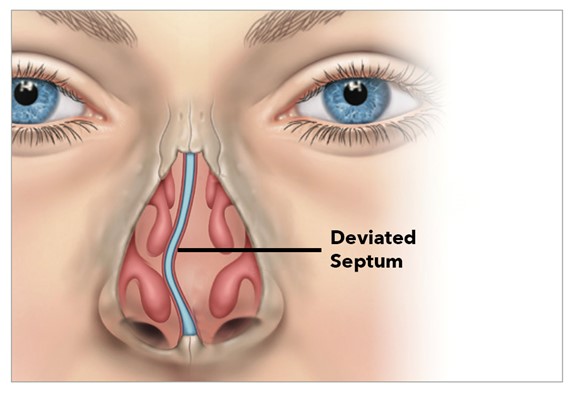A deviated septum is a common condition that can affect breathing and overall nasal health. The septum is the cartilage and bone structure that divides the two nostrils. Ideally, it should be centered, allowing air to flow freely through both sides of the nose. However, in many people, the septum is slightly off-center or deviated, which can cause various symptoms.
What is a Deviated Septum?
A deviated septum occurs when the nasal septum is displaced to one side, making one nasal passage smaller than the other. This misalignment can result from congenital factors, meaning someone is born with it, or it can develop after an injury to the nose. Many people may have a slight deviation in their septum without significant symptoms, but in some cases, the deviation can be severe enough to cause breathing problems and other complications.
Symptoms of a Deviated Septum
The symptoms of a deviated septum can vary from mild to severe, depending on the extent of the deviation. Some common symptoms include:
- Difficulty Breathing Through the Nose: One of the most common symptoms is trouble breathing through one or both nostrils. This can be especially noticeable during exercise or when lying down.
- Nasal Congestion: Chronic congestion on one or both sides of the nose can occur, often leading to the frequent use of nasal sprays or other decongestants.
- Frequent Nosebleeds: A deviated septum can cause the nasal passages to dry out, leading to frequent nosebleeds.
- Sinus Infections: A deviated septum can interfere with normal drainage from the sinuses, increasing the risk of sinus infections.
- Facial Pain or Headaches: The pressure from a deviated septum can cause facial pain or headaches, particularly around the eyes and forehead.
- Snoring and Sleep Apnea: A deviated septum can contribute to snoring and sleep apnea by obstructing the airway during sleep, leading to interrupted breathing.
- Postnasal Drip: Mucus can build up in the throat due to poor drainage, causing a sensation of postnasal drip.
Diagnosis of a Deviated Septum
If you suspect you have a deviated septum, it’s important to see a healthcare provider for an accurate diagnosis. Here’s how the process typically works:
- Medical History: Your doctor will begin by asking about your symptoms, including any difficulties with breathing, snoring, or recurring sinus infections.
- Physical Examination: During a physical exam, the doctor will look inside your nose using a speculum or an endoscope, which allows for a detailed view of the nasal passages. This helps to determine the severity of the deviation.
- Imaging Tests: In some cases, imaging tests such as a CT scan or X-ray may be recommended to get a more detailed view of the nasal structures.
- Allergy Testing: Since some symptoms of a deviated septum can overlap with allergies, your doctor may also conduct allergy testing to rule out other causes of your symptoms.
Treatment Options for a Deviated Septum
Treatment for a deviated septum depends on the severity of the symptoms and how much they interfere with your daily life. Here are some common treatment options:
- Medications
For mild symptoms, medications can help manage the condition. These might include:
- Decongestants: These can reduce nasal tissue swelling, helping to keep the airway open. However, they should not be used for long periods as they can lead to dependency.
- Antihistamines: If allergies are contributing to your symptoms, antihistamines can help by reducing allergic reactions and symptoms such as a runny nose or nasal congestion.
- Nasal Steroid Sprays: These sprays can reduce inflammation in the nasal passages, providing relief from congestion and other symptoms.
- Nasal Strips
Nasal strips can help open the nostrils, improving airflow and reducing symptoms like snoring.
- Septoplasty
For those with severe symptoms that don’t respond to other treatments, surgery may be necessary. Septoplasty is a surgical procedure to straighten the septum, improving airflow through the nasal passages. This outpatient procedure usually takes about 60 to 90 minutes and involves reshaping or repositioning the bone and cartilage of the septum.
- Rhinoplasty
In some cases, septoplasty may be combined with rhinoplasty, a procedure that changes the shape of the nose for cosmetic or functional reasons.
Recovery After Surgery
If you undergo septoplasty, the recovery process typically involves a few weeks of healing. You may experience some swelling, discomfort, and congestion in the days following surgery. Your doctor will provide instructions on how to care for your nose during recovery, including using saline sprays and avoiding strenuous activities.
Conclusion
A deviated septum is a common condition that can lead to a variety of symptoms, from difficulty breathing to chronic sinus infections. While some people may not require treatment, others may benefit from medications, nasal strips, or surgery. If you’re experiencing symptoms, it’s important to consult with a healthcare provider to determine the best course of action for your situation. Understanding the condition and knowing your treatment options can significantly improve your quality of life.

Septum: A deviated septum occurs when the nasal septum (the cartilage and bone that divide the nasal cavity) is off-center,